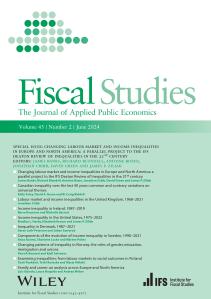Access
We assess the impact of nationwide minimum wages on employment throughout the whole wage distribution by exploiting geographical variation in the level of wages. We find a substantial increase in wages at the bottom of the wage distribution, while we detect a small, statistically insignificant negative effect on employment. Combining the estimated change in the wage distribution with a tax and benefit microsimulation model, we show that the minimum wage generates considerable proportional income gains up to the middle of the household income distribution.
Authors

Research Fellow Bocconi University
Giulia, an Assistant Professor of Economics at Bocconi University, studies the employment and welfare effects of social insurance and minimum wages.

Deputy Director
Robert is a Deputy Director. His work focuses on primarily on the labour market, income and wealth inequality, and the design of the welfare system.

Research Fellow University College London
Attila is an IFS Research Fellow, an Associate Professor of Economics at the University College London and Adjust Professor at the University of Oslo.

Associate Director
Tom is an Associate Director at the IFS and Head of the Income, Work and Welfare sector.

Research Economist
Tom is a Research Economist in the Income, Work and Welfare sector, having joined the IFS in 2020.

Senior Research Economist
Xiaowei joined the IFS in 2018 and works in the Income, Work and Welfare sector.
Journal article details
- DOI
- 10.1086/728471
- Publisher
- University of Chicago Press
- ISSN
- 0734-306X
- Issue
- Volume 42, Issue S1, April 2024, pages 293-333
Suggested citation
Giupponi, G et al. (2024). 'The employment and distributional impacts of nationwide minimum wage changes' 42(S1/2024), pp.293–333.
More from IFS
Understand this issue

What are the challenges in getting debt on a falling path?
28 June 2024

Election Special: Your questions answered
27 June 2024

What is the two-child limit in benefits?
27 June 2024
Policy analysis

How would the parties’ tax and spending plans affect Scotland and Wales?
28 June 2024

Free breakfast clubs in schools: what Labour’s plans would mean for pupils and families
25 June 2024

General Election 2024: Manifesto Analysis Presentations
24 June 2024
Academic research

Fiscal Studies: Volume 45, Issue 2
28 June 2024

Income inequality in Ireland, 1987–2019
28 June 2024

Inequality in Denmark, 1987–2021
28 June 2024